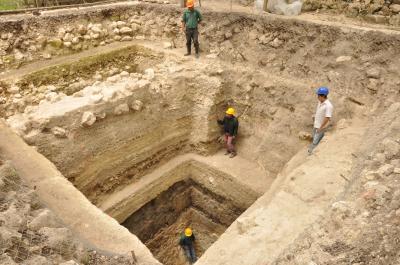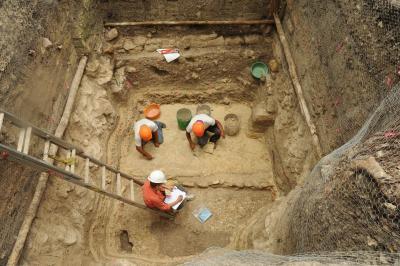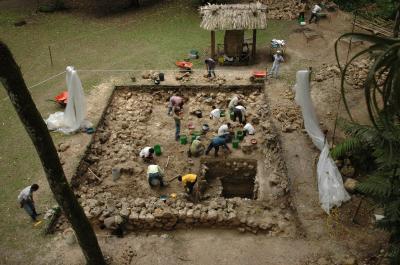The ancient Maya civilization of Mesoamerica may have developed its unique culture and architecture via contact with many other groups—not just exclusive contact with the Olmec people or on its own, without any outside influences, as researchers have debated. According to a new study, the formal plazas and pyramids at Ceibal, an ancient Maya site in Guatemala, probably arose from broad cultural exchanges that took place across southern Mesoamerica from about 1,000 to 700 BCE.
Until now, two theories have dominated the debate concerning the origin of the Maya civilization: one suggesting that the Maya developed almost entirely on their own in what is now southern Mexico, Guatemala, and Belize, and another suggesting that the older Olmec civilization was the Maya's dominant cultural influence. Takeshi Inomata and Daniela Triadan, a husband-and-wife team from the University of Arizona in Tucson, along with colleagues from the U.S. and Japan, however, found that neither of these theories could tell the full story of the Maya.
"In terms of the origins of lowland Maya civilization, their relationship [with the Olmec] is always a focus of debate," Inomata explained. "We're now saying that it probably wasn't just the Olmec, but a lot of other groups—for example, those living in central Chiapas and those on the southern Pacific coast—that had a lot of important interactions with the lowland Maya."
The researchers' report appears in the 26 April issue of the journal Science, which is published by AAAS, the science society.

This shows the excavation of Platform A-24 at Ceibal, Guatemala, which revealed the oldest monumental construction in the Maya lowlands.
(Photo Credit: [Photograph by Takeshi Inomata])
By the time sedentary communities began appearing in the Maya lowlands of southern Mexico, Guatemala, and Belize during what's known as the early Middle Preclassic period—from about 1,000 to 700 BCE—the Gulf Coast Olmec were already well-established in nearby regions, researchers say. Given this timeline, many anthropologists have viewed the Olmec as a "mother culture," or one that provided cultural innovations, such as art styles and political structure, to other populations.
The coastal Olmec hub of La Venta, for example, hosted architectural styles that were likewise found at Ceibal. But, Inomata and the other researchers now provide radiocarbon dating measurements taken from some of the ceremonial structures at Ceibal, like plazas and platforms, which predate the growth of La Venta as a major center by as much as 200 years. These findings imply that La Venta could not have been the primary influence on Ceibal that researchers once thought it was. Instead, Inomata and his team suggest that both Ceibal and La Venta participated in a broader cultural shift that was taking place in Mesoamerica between about 1,150 and 800 BCE.
"The main complex at Ceibal is made up of a plaza area, a western platform or pyramid and an eastern mound," said Inomata. "This is generally known as an 'E-Group Assemblage,' and they can be found across southern Mesoamerica." Many researchers have resisted using the term to refer to the structures at La Venta, since it was originally coined to describe Mayan architecture. But, Inomata and his team argue that the ceremonial constructions at La Venta should also be classified as such E-Group Assemblages.

This is an early residential structure found at the East Court of Ceibal, Guatemala.
(Photo Credit: [Photograph by Takeshi Inomata])
"Possibly, their uses were very similar," Inomata continued. "Ritual was very important to these civilizations, and there is a series of ritual deposits in the plaza at Ceibal… Such rituals often included greenstone axes, made from jade or other imported, precious stones, which were deposited [in the plaza] as a kind of offering."
Such ritualistic offerings have been found elsewhere in southern Mesoamerica, including two contemporaneous sites in Chiapas, Mexico.
Inomata and his team suggest that E-Group Assemblages at Ceibal began as small structures, just two meters tall. But, with continuous renovation, the ceremonial constructions grew taller and taller, eventually becoming pyramids, which became very important to the later Maya people.
Taken together, the findings do not suggest that the Maya civilization was older than the Olmec culture, nor do they prove that the Maya developed independently. Instead, they show that the Maya actively participated in a major social shift that took place over a wide area.
"We are seeing this new form of architecture, which probably reflects a new form of society and social order," says Inomata. "This new form of social order emerged not from one center, such as the Gulf Coast Olmec, but through broad interactions among diverse groups, including the lowland Maya."

This is the excavation of Platform A-24 at Ceibal, Guatemala.
(Photo Credit: [Photograph by Takeshi Inomata])